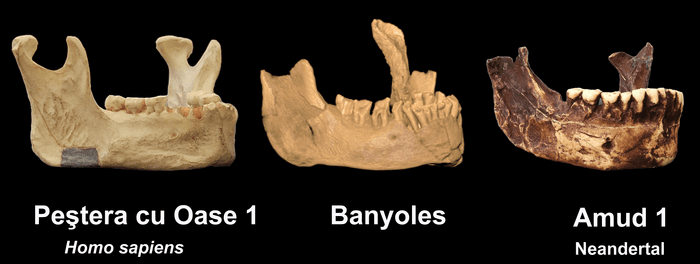A jawbone discovered over a century ago in the Spanish town of Banyoles may represent the earliest documented presence of modern humans in Europe. Intriguingly, however, the mandible doesn’t quite match up with that of any known human species, indicating that the fossil’s long-dead owner may have descended from a mysterious group of unknown ancient hominids.
Unearthed in a quarry in 1887, the Banyoles specimen is thought to be between 44,000 and 65,000 years old, and therefore hails from a time when Neanderthals were in their pomp. “The mandible has been studied throughout the past century and was long considered to be a Neandertal based on its age and location, and the fact that it lacks one of the diagnostic features of Homo sapiens: a chin,” said Binghamton University graduate student and study author Brian Keeling in a statement.
Using a method called three-dimensional geometric morphometrics (3D GM), the researchers digitally reconstructed the missing parts of the old bone, creating a computerized model of the entire mandible. In doing so, they were able to compare the fossil to the jaws of both Neanderthals and Homo sapiens.
“Our results found something quite surprising – Banyoles shared no distinct Neandertal traits and did not overlap with Neandertals in its overall shape,” said Keeling. In fact, the authors write that “The 3D GM analysis clearly grouped Banyoles with H. sapiens” in terms of overall shape, although the fact that it lacks a chin makes it difficult to assign the fossil to a specific species.
Bearing in mind that some ancient Homo sapiens had less pronounced lower jaws than the chinny humans roaming the Earth today, the study authors decided to compare the Banyoles specimen to another of Europe’s earliest modern human fossils, which hails from Peştera cu Oase in Romania.
Previous research on this individual – known as Oase 1 – has revealed that the specimen contains between six and nine percent Neanderthal DNA, and was a modern human-Neanderthal hybrid. Despite this, Oase 1 has a much more developed chin than Banyoles.
“We were confronted with results that were telling us Banyoles is not a Neandertal, but the fact that it does not have a chin made us think twice about assigning it to Homo sapiens,” explained study author Rolf Quam. “The presence of a chin has long been considered a hallmark of our own species.”
The complete lack of Neanderthal features rules out the possibility of Banyoles representing a Homo sapiens-Neanderthal hybrid, leaving the researchers with two plausible theories. The first of these is that Banyoles was a member of a previously unknown population of modern humans that lived at a time when Europe was thought to have been inhabited solely by Neanderthals, and which lacked a proper chin.

Comparison of the Banyoles mandible (center), with H. sapiens (left), and a Neanderthal (right). Image credit: Brian Keeling
Alternatively, the specimen may be the result of hybridization between Homo sapiens and another completely unknown hominid species. However, the study authors explain that “while the lack of chin structures in Banyoles might be explained by admixture with a non-Neandertal archaic Homo form, no such population has been identified in the Late Pleistocene European fossil record.” In fact, the only other non-Neanderthal hominid remains in Europe predate Banyoles by around 300,000 years, all of which makes it highly unlikely that modern humans interbred with such a species.
Whether the specimen turns out to be a modern human or not, the fact that it is not a Neanderthal is massively significant, as no other human species is thought to have existed in Europe at this time.
“If Banyoles is really a member of our species, this prehistoric human would represent the earliest H. sapiens ever documented in Europe,” said Keeling.
The research is published in the Journal of Human Evolution.
Source Link: Ancient Jawbone May Belong To Europe’s Earliest Modern Humans – Or A Mystery Hominid